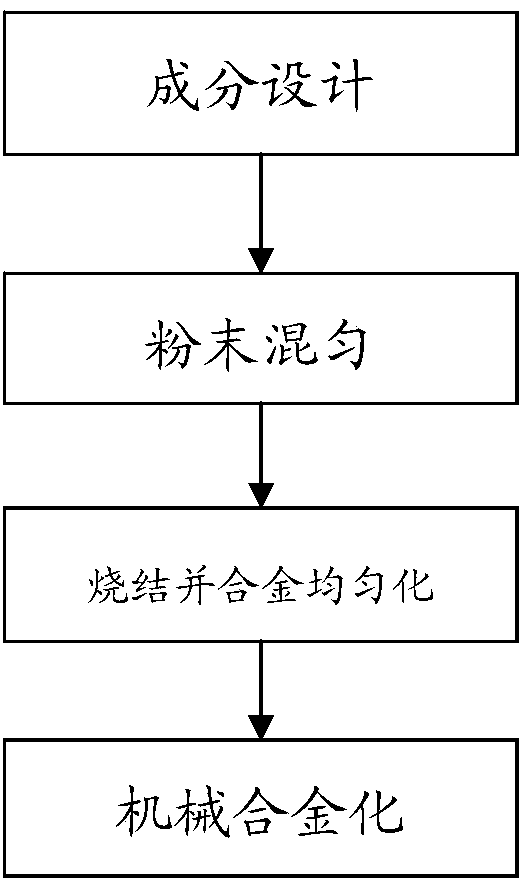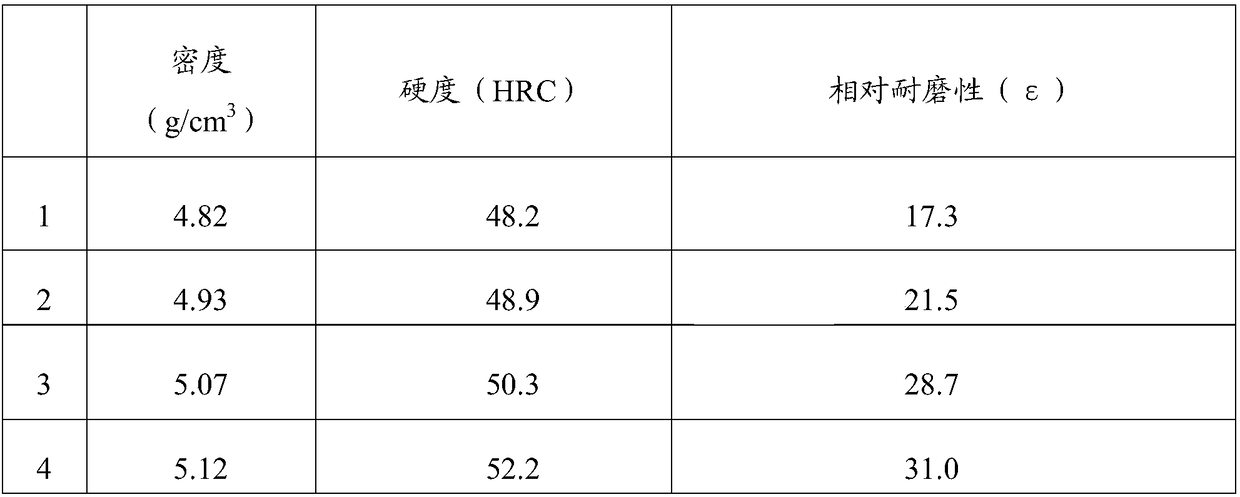A titanium-based alloy material for 3D printing containing tungsten and its preparation method
A titanium-based alloy, 3D printing technology, applied in the direction of additive processing, etc., can solve the problems of poor plastic shear deformation resistance and wear resistance, limited use, low strain hardening index, etc., to achieve breakthrough limitations, high temperature wear resistance Excellent performance, high temperature hardness effect
- Summary
- Abstract
- Description
- Claims
- Application Information
AI Technical Summary
Problems solved by technology
Method used
Image
Examples
Embodiment 1
[0035] Please refer to figure 1 Take 1.5 kg of tungsten carbide powder, 0.5 kg of nickel powder, 0.8 kg of niobium powder, 0.3 kg of vanadium powder, 0.8 kg of copper powder, 1.0 kg of molybdenum powder, and 5.1 kg of titanium powder. The thickness is 30-150 μm, and the oxygen content is 0.07-0.12%. Put the obtained powder into a powder mixer and mix for 10 minutes until the mixture is uniform.
[0036] The mixed powder is sintered and subjected to alloy homogenization.
[0037] The product is mechanically alloyed to obtain a powder product. Mechanical alloying is a complex physical and chemical process in which powder undergoes repeated deformation, cold welding, and crushing through high-energy ball milling to achieve alloying at the atomic level between elements.
[0038] The alloy powder particles are spherical in shape, the particle diameter is 30-150 μm, and the oxygen content is 0.07-0.12%.
[0039] 3D printing with the obtained finished powder, the printing paramet...
Embodiment 2
[0042] Take 2.0 kg of tungsten carbide powder, 0.4 kg of nickel powder, 0.6 kg of niobium powder, 0.2 kg of vanadium powder, 0.7 kg of copper powder, 0.8 kg of molybdenum powder, and 5.3 kg of titanium powder. 30~150μm, oxygen content is 0.07~0.12%. Put the obtained powder into a powder mixer and mix for 10 minutes until the mixture is uniform.
[0043] The mixed powder is sintered and subjected to alloy homogenization.
[0044] The product is mechanically alloyed to obtain a powder product. Mechanical alloying is a complex physical and chemical process in which powder undergoes repeated deformation, cold welding, and crushing through high-energy ball milling to achieve alloying at the atomic level between elements.
[0045] The alloy powder particles are spherical in shape, the particle diameter is 30-150 μm, and the oxygen content is 0.07-0.12%.
[0046] 3D printing with the obtained finished powder, the printing parameters are: construction speed: 40cm 3 / h, laser scann...
Embodiment 3
[0049] Take 2.5 kg of tungsten carbide powder, 0.3 kg of nickel powder, 0.4 kg of niobium powder, 0.2 kg of vanadium powder, 0.6 kg of copper powder, 0.6 kg of molybdenum powder, and 5.4 kg of titanium powder. 30~150μm, oxygen content is 0.07~0.12%. Put the obtained powder into a powder mixer and mix for 10 minutes until the mixture is uniform.
[0050] The mixed powder is sintered and subjected to alloy homogenization.
[0051] The product is mechanically alloyed to obtain a powder product. Mechanical alloying is a complex physical and chemical process in which powder undergoes repeated deformation, cold welding, and crushing through high-energy ball milling to achieve alloying at the atomic level between elements.
[0052] The alloy powder particles are spherical in shape, the particle diameter is 30-150 μm, and the oxygen content is 0.07-0.12%.
[0053] 3D printing with the obtained finished powder, the printing parameters are: construction speed: 40cm 3 / h, laser scann...
PUM
| Property | Measurement | Unit |
|---|---|---|
| particle diameter | aaaaa | aaaaa |
Abstract
Description
Claims
Application Information
 Login to View More
Login to View More - R&D
- Intellectual Property
- Life Sciences
- Materials
- Tech Scout
- Unparalleled Data Quality
- Higher Quality Content
- 60% Fewer Hallucinations
Browse by: Latest US Patents, China's latest patents, Technical Efficacy Thesaurus, Application Domain, Technology Topic, Popular Technical Reports.
© 2025 PatSnap. All rights reserved.Legal|Privacy policy|Modern Slavery Act Transparency Statement|Sitemap|About US| Contact US: help@patsnap.com


